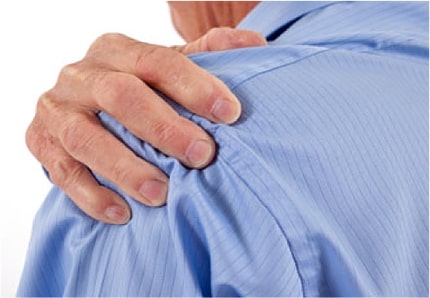The shoulder is a complex and flexible joint that is essential to every day activity. The shoulder, like the hip is a ball and socket joint. As humans have evolved and no longer use our arms to walk, the shoulder has changed to allow us to have a greater degree of movement of the upper limb. The consequence of increased movement of the shoulder, however, is a reduction in stability and a greater chance of injury. Here are some of the causes of Acute Shoulder Pain.

Shoulder Tendonitis
is very common shoulder injury. Shoulder tendonitis commonly affects the tendons of the rotator cuff muscles, which help to provide active stabilization to the shoulder and the tendon of the biceps muscle.
Shoulder tendonitis is more often caused by overuse of the tendons rather than a single trauma. Over time repeated microtraumas, caused when the tendons are squashed or impinged between the bones of the shoulder, leads to inflammation, swelling and pain.
Calcific Tendonitis
occurs when small calcium deposits form in the tendons as they heal. It is unclear why this occurs in some cases of tendonitis, however it is likely that this is a protective mechanism within the body due to a prolonged healing time.
In most cases the body reabsorbs the calcium over time, however this can be a very painful process.
Shoulder Bursitis
is another common shoulder condition arising from overuse of the shoulder. The bursa located under the boney prominence of the shoulder is a fluid filled sack, which reduces the rubbing of the soft tissues over the shoulder bones. Repetitive squashing of the bursa may lead to inflammation, swelling and pain.
Rotator Cuff Tear
describes a tear of the tendons of the rotator cuff muscles. Rotator cuff tears occur in two different ways:
- Traumatic Tear: occurring from a single one off injury such as a fall or lifting a heavy load
- Repeated microtrauma: occurring as a progression of shoulder tendonitis where small tears and inflammation become larger and more debilitating
Rotator cuff tears can be partial or full thickness tears through the tendon and cause pain as well as weakness which reduces shoulder function.
Shoulder tendonitis, bursitis and even rotator cuff tears often respond well to Physiotherapy and conservative management. Some large rotator cuff tears may require surgery.
Shoulder Dislocation
occurs when the ball of the shoulder comes out of the socket. A dislocated shoulder is usually associated with extreme pain until the shoulder can be relocated. A shoulder subluxation, or partial dislocation can also occur where the shoulder comes part of the way out of the socket before relocating itself.
Shoulder dislocations can occur in two ways:
- Traumatic Dislocation where the shoulder is placed into an awkward position at a high speed (eg. A football tackle)
- Shoulder Instability which can either occur as a result of repeated traumatic dislocations where the ligaments become stretched or where there is naturally flexible ligaments (double jointed shoulder).
Once a shoulder has been dislocated it is much more likely to re-dislocate. This can occur with less force and may even happen during normal daily activities. Depending on your age and the level of activity you need to get back to you may need surgery to recover from your shoulder dislocation.
Shoulder Labral Tear
can occur in combination with a traumatic shoulder dislocation. The shoulder labrum is a cartilage pad that acts as a suction cup to assist In making the shoulder more stable. A labral tear is sometimes named by the pattern or shape of the tear (eg. SLAP tear or Bankart lesion).
Similar to a shoulder dislocation a labral tear makes further dislocation more likely and may require surgery as well as physiotherapy.
Shoulder Separation
occurs when the ligaments of the acromio-clavicular (AC) joint are torn causing a dislocation of the joint between the shoulder and collar-bone.
The AC joint can be dislocated from a direct force such as a fall onto the shoulder from a bicycle or in a football tackle. A fall onto an outstretched arm can also cause the AC joint to “pop.”
Shoulder separation usually responds well to conservative treatment and does not require surgery.
Frozen Shoulder
occurs as a result of chronic inflammation of the shoulder capsule. This inflammation results in shrinking and stiffening of the shoulder capsule causing the characteristic lack of movement or freezing of the shoulder.
Little is known about the cause of frozen shoulder and recovery can take longer than two years.
